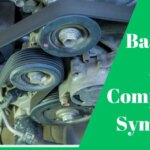
When to replace fuel injectors is a common concern for any car owner. With fuel injectors, there are telltale signs that it’s time to “upgrade” them. Like any other mechanical or computerized machine, fuel injectors will eventually start to wear out. If you have reached a certain mileage or you see any sign of wear and tear, it’s time to get it replaced.
You should change fuel injectors when it’s served you 50k-100k miles, or you see that your vehicle has some symptoms, including misfiring, consuming more fuel than normal, gas odor, check engine light turning on, or fuel leaking.
Let’s look into the details.
Table of Contents
When to Replace Fuel Injectors
#1 How Long Does a Fuel Injector Last

Typically, an injector lifetime can be up to 100k miles but it depends on many other factors as well. Sometimes, the car owner is unaware of how many were used. That’s why it’s important to consider all the possible factors before you go for an injector change. Here are some common ones:
Fuel Quality
Aside from the running miles, the type of fuel your vehicle uses may also affect the injectors’ life span. Most fuel injectors can last up to 50k on average, but some injectors may not reach 30k miles. If your vehicle uses ethyl gasoline, it can go longer than if it runs with high-octane gas. This is because running with high-octane gas will clean the emissions quicker, removing the carbon deposits on the inside of the injector. This leads to less wear and tear on the injectors.
Driving Conditions
City driving might affect fuel mileage, while racing may shorten injectors’ life span. In addition, some fuel injectors may be used in different models of the same car. Be sure to check your car on a regular basis and clean it from time to time, this will help extend its lifetime.
Air Filters
Your fuel system might have been affected by an air filter that needs replacing. It can block the air supply needed for proper fueling. This can cause the injector to fail prematurely.
Poor Maintenance
Most of the time, the fuel injectors are hard to spot. This makes you think that it’s okay even if you didn’t clean them for a long time. Some owners only inspect the fuel injectors when they detect a problem. Lack of maintenance also reduces their lifetime.
Usage of Aftermarket Parts
They might affect your car’s performance, and that’s why some car owners decide to replace them with OEM parts instead of aftermarket ones. Aftermarket parts are cheaper but may cut the fuel injector’s life span.
#2 Bad Fuel Injector Symptoms

If you think that you are due for injector replacement, check out some telltale signs that your injectors are about to fail soon. They are:
Check Engine Light Turning On
As early as 15k miles before they fail, some cars develop “misfire” which causes their check engine lights to turn on. The levels of misfiring are beyond the manufacturer’s recommendations.
Remember that there are many reasons causing the Check Engine Light to turn on, bad or clogged fuel injectors can be one of them.
Fuel Odor
If you smell something rotten in your car, it might be time to change it. You can test this by switching out your fuel and driving around for a while. If it doesn’t smell, chances are they won’t fail soon.
Misfiring
You can check your car for this by observing the idle. If you notice that the vehicle keeps running rough or having trouble accelerating, it’s a big indicator that you have a misfiring problem. Misfiring means that those fuel injectors are not working as they should. It occurs when your car is unable to get a proper supply of air and gas mix in the combustion chamber.
Your check engine light will turn on, and you’ll need replacement injectors.
Fuel Leaking
If the fuel injectors are damaged or cracked, they may start leaking fuel. Check for a fuel trail of smoke coming from the damaged area. If it’s leaking, you need to replace it right away.
The milky color of the injector is another sign that it has already cracked.
Declining Fuel Efficiency
If your vehicle’s fuel efficiency declines, it’s an indicator to consider an injector replacement. Check, and if the intake and exhaust temperatures are sticking out too high, chances are that there is a problem with the fuel injectors.
Fail injectors send wrong data to the ECU to demand more fuel than the car needs. This can also increase the emission level.
Causes of fuel injector failure
Fuel injector failure can be caused by a number of factors, including fuel contamination, mechanical wear and tear, electrical problems, or clogged injectors.
Fuel contamination
Fuel contamination can occur when contaminants such as dirt or water enter the fuel system and become trapped in the injector. This will hamper the flow of fuel through the injector, resulting in poor combustion and eventual engine performance issues.
Wear and tear
Mechanical wear and tear on components like seals, O-rings and other parts of the fuel system can also cause an injector to fail. Over time these parts lose their tight seal and can no longer properly regulate fuel pressure.
Electrical issues
Electrical problems such as faulty wiring or short circuits can also cause an injector to malfunction.
Clogging or blockages
Lastly, clogged injectors are a common issue that arises from a buildup of deposits on the nozzle tip that prevent it from opening properly. These deposits occur due to poor quality fuel or incorrect injection timing/pressure settings.
Testing fuel injectors
To diagnose a faulty fuel injector, it is necessary to test the unit. This can be done in several ways such as ohmmeter testing, spray pattern testing and flow rate testing. Once any issues are identified, they must then be repaired or replaced to restore proper engine operation.
Visual inspection for physical damage or leaks
Visual inspection for physical damage or leaks in fuel injectors is an important part of a comprehensive maintenance program. A visual inspection should be done both before and after any work performed on the fuel injector, such as cleaning or replacement. During a visual inspection, the following points should be examined:
- External Condition: Check for any obvious signs of physical damage, wear, and tear, corrosion, or leakage from the fuel injector. Look for cracks in the body of the injector that could compromise its functionality. Look for any evidence of leaking fuel around the surrounding components, such as the fuel tank or lines.
- Connections: Examine all electrical and vacuum connections to ensure they are firmly secured to prevent leaks and prevent sparking, which can cause dangerous engine fires. Also, check that all wires are securely connected and undamaged.
- Seals: Inspect all o-rings, gaskets, and seals to make sure they are in good condition and not worn or cracked. Make sure they are properly aligned with no gaps or misalignments when reinstalled during any work performed on the injector.
- Interior Components: Carefully examine all internal components, including spray nozzles, plunger assembly, valves, and other parts, to check for signs of damage due to wear and tear or contamination of dirt or debris. Any damaged parts should be replaced with new ones immediately to prevent further problems with performance or fuel delivery efficiency.
Resistance testing for electrical issues
Resistance testing is an important tool for troubleshooting electrical issues in fuel injectors.
In order to perform this diagnostic, you need an ohmmeter or multimeter and access to the vehicle’s wiring harness.
First, disconnect the injector’s power supply and ground wires from the vehicle’s wiring harness.
Then, set your meter to measure resistance, and touch the exposed ends of both wires simultaneously with the probes. The meter should read close to 0 ohms if both contacts are functioning properly. If there is any significant difference in resistance values from one side of the wire to another, it could be indicative of a faulty connection or broken wire within the injector assembly.
It is also possible to test the injector solenoid by placing one probe on its coil terminal and the other on its return terminal, or ground connection. This should produce a consistent reading between 1-2 ohms if everything is functioning correctly. If you measure no resistance at all, then it could indicate an issue with either the coil or contact points within the solenoid itself.
Resistance testing can help quickly identify electrical problems in fuel injectors, but it’s not necessarily a foolproof method of diagnosing these components accurately every time. If a faulty reading is obtained during your tests, it’s best to double check by performing a voltage drop test as well as a visual inspection of wiring connections and circuits before making any assumptions about what may be causing the issue.
Fuel pressure and flow testing
A fuel pressure test checks the amount of pressure from the fuel pump to the injector. A special gauge is used to measure the outgoing pressure. Low pressure can stop fuel from going into the engine and make it go bad.
Flow testing checks how much fuel goes into each cylinder. A flow meter is connected to each line and measures the amount of fuel going through. This helps find out if the injectors are working correctly, which can cause problems like a rough idle or smoke from the exhaust.
In order to properly conduct both tests, all components such as filters, regulators, and hoses should be in good condition and checked for any signs of wear or damage prior to testing. It’s also important to understand what readings are expected for specific vehicles so that any irregularities can be quickly identified and addressed before further damage occurs.
Cylinder balance testing
Cylinder balance testing of fuel injectors requires precise measurements of the individual cylinder’s fuel injector flow rate.
This can be done by attaching a flow meter to the test stand and running a calibrated test for each injector.
During the test, the fuel pressure and temperature should remain constant. After measuring the flow rate, it is important to measure each cylinder’s volumetric efficiency and compare it to the rest of the cylinders on the engine.
An imbalance in volumetric efficiency between cylinders may indicate an issue with one or more of the injectors or other components within the engine. If an imbalance is observed, further testing may be required to identify exactly where the issue is coming from.
For example, if high fuel injection pressures are found at a particular cylinder, then that injector may need to be serviced or replaced.
Besides, faulty spark plugs or clogged air filters can lead to incorrect fueling ratios and should be checked as well.
How to Change Your Fuel Injectors?

Fuel injector replacement needs special equipment and tools. You can shop for them at your local auto parts stores or order them online. If you’re skillful enough, then you can do it yourself. However, I highly recommend you get help from a professional.
When you take your car to a mechanic shop, expect to pay up to $1500 (this number varies on your make and model). The parts themselves are quite expensive, not to mention the labor cost. If you want to save some money, you can go for aftermarket parts. So make sure you look around for your budget.
Cleaning Fuel Injectors: How-To
Cleaning fuel injectors regularly (after every 30k miles) can help to prolong their life and prevent them from getting clogged. This cleaning job isn’t that challenging and costly. If you opt for a DIY task, you just need a fuel injector cleaning kit, check out this article for more details:
> How to Clean Fuel Injectors Without Removing Them
Otherwise, get help from experts. You can set aside around $200-300 for this service.
Using fuel injectors cleaner
Most fuel injector cleaners have polyisobutylene amine in them, which may be better than using gas treatments. These additives can help clear your fuel injector of any deposits and jams. Your fuel injector’s performance can be recovered with a cleaning.
How to use fuel injectors cleaner:
It’s important to use fuel injectors cleaner when your gas tank is almost empty. By doing so, the cleaner can mix well with the fuel to get the best result.
Step 1: Choose the product that best suits your car.
Step 2: Calculate the appropriate amount of fuel injector cleaning to use in your car.
Step 3: Fill the tank with the necessary quantity of fuel injector cleaner.
Step 4: Fuel the car up to the recommended level.
For information on how much fuel injector cleaning to use, read the label and refer to the manufacturer’s recommendations.
Check out this video on how to clean fuel injectors with simple tools
Preventing fuel injector failure
Preventing fuel injector failure requires a multi-faceted approach.
Regular maintenance and cleaning of fuel injectors is essential to keep them functioning optimally. This includes checking fuel filters and hoses, inspecting the nozzles, and replacing dirty or worn parts.
Using only high-quality fuel and performance additives can help reduce deposits that can clog the fuel injectors.
Besides, addressing any engine issues promptly such as faulty spark plugs or other ignition problems can help reduce the risk of fuel injector failure.
By taking this comprehensive approach, drivers can ensure their engines are running efficiently and that their fuel injectors will remain in peak condition for years to come.
FAQs
Should I replace or clean my injectors?

Fuel injectors should be cleaned every 45,000 miles or every 36 months. In general, it is not a good idea to replace weak or worn-out engine components without enhancing performance. However, cleaning out dirty injectors might provide a new perspective on engine health.
Is fuel injector replacement expensive?
Fuel injector replacement is not inexpensive. It will vary considerably depending on where you reside, what brand you wish to use, and where you place it. However, you should budget up to $350. The parts will cost you only up to $200 at most, with the remainder going toward labor and installation.
It’s important to remember that you might not have to replace the faulty fuel injector or injectors. The issue might be resolved by a thorough cleaning of the fuel injector, saving you the expense of an entirely new replacement part.
Should I change all injectors at once?

The severity of the problem and your car will determine whether you should repair only the one malfunctioning fuel injector or all of them at once.
For instance, the cost of replacing a fuel injector in a diesel truck will include a sizable portion of labor alone. Therefore, the most cost-effective course of action may be to replace all fuel injectors due to their labor-intensive nature. The last thing you want is to spend a fortune replacing one diesel truck’s fuel injector just to have another fail shortly after.
On the other hand, it can be more cost effective just to replace the problematic part if a fuel injector malfunctions in a tiny automobile with a gasoline engine.
Can I still drive with bad fuel injectors?
While it is possible to drive for a short period of time with a damaged fuel injector, it is not advised. Try to reduce it as much as you can if you must continue driving despite a suspected fuel injector failure.
Even while a single malfunctioning fuel injector isn’t a serious issue in and of itself, driving with one could result in other engine issues.
It’s important to note that more recent cars will make it easier to drive with faulty fuel injectors. Modern cars have sophisticated electronics that enable the engine to partially make up for a malfunctioning fuel injector.
How often should you replace fuel injectors?
Fuel injectors should be replaced every 40,000 to 100,000 miles, depending on the make and model of the vehicle.
Over time, fuel injectors can become clogged with dirt and residue, which can lead to decreased engine performance, fuel economy and increased emissions.
It is important to replace fuel injectors regularly in order to keep your vehicle running at its optimal level.
How much does it cost to replace fuel injectors?
The cost of replacing fuel injectors depends on several factors, including the make and model of the vehicle, the type of fuel injector being replaced, and labor costs.
For example, a set of new fuel injectors for a mid-sized sedan can typically range from $150 to $450 with installation costs ranging from $400 to $800 depending on the complexity of the job.
If you are replacing a single fuel injector, expect to pay around $200-$300 plus installation labor.
Final Words
Fuel injectors won’t last forever. They need to be replaced in due time. Whether you do it yourself or let someone else do it, the most important thing is to keep them checked regularly and early diagnosis.
Observe your car’s performance, and if it doesn’t feel right, then the best thing that you can do is replace it. You don’t have to wait until they fail. Just follow these tips, and you can extend their life span by quite a lot.
Changing fuel injectors is a major job that requires a lot of skill, patience, and experience. If you don’t have the right tools and experience, you might end up doing more harm than good. Take your car to an automotive shop if needed.
Further reading:
Hi there! I’m Naomi O’Colman. I’ve got years of experience working at an auto repair shop here in Texas under my belt. On top of that, ever since I was a kid I’ve been passionate about the auto industry. Since I’ve joined the team at automotivegearz.com I’ve been enthusiastically sharing my passion and insights with my readers. I’m dedicated to delivering high quality content and helping you stay up to date with the latest automotive trends and products out there!







